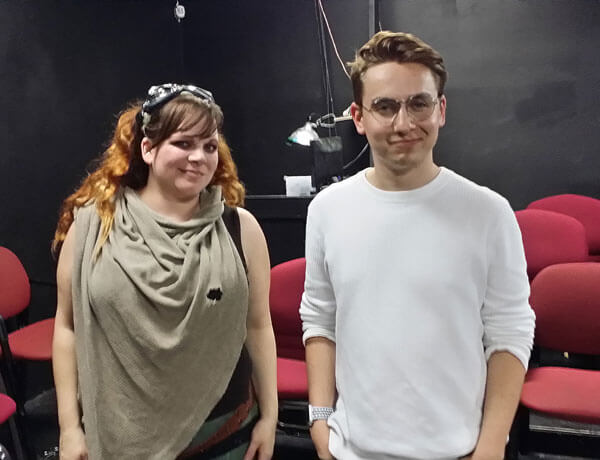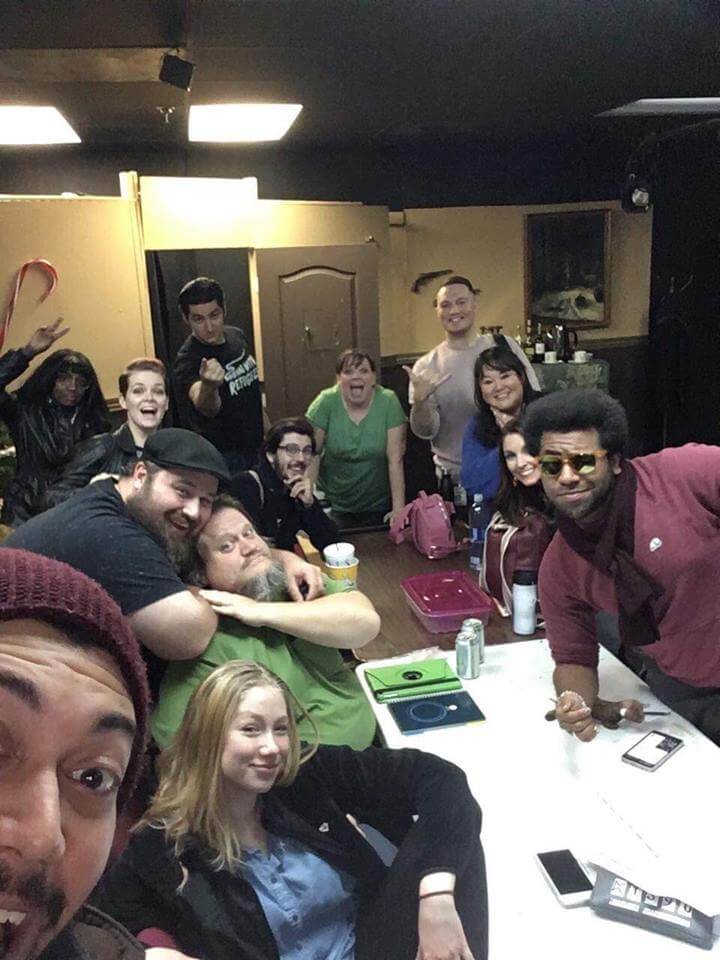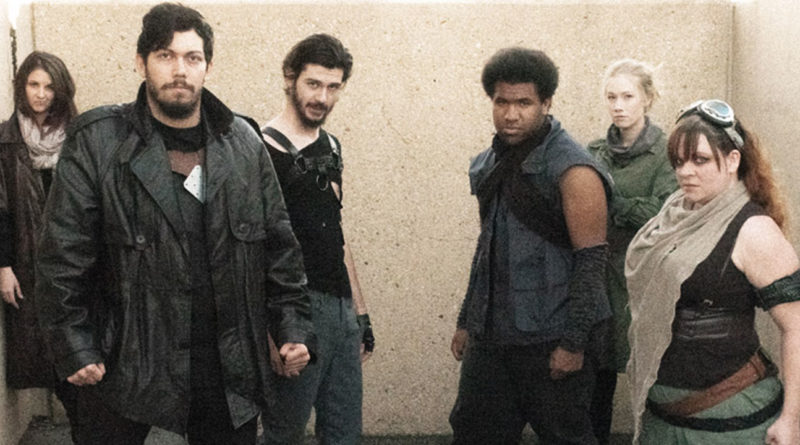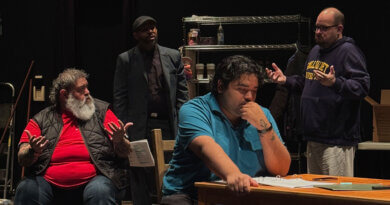Interview: Morgan Clyde and Caleb Craig on ‘By Our Hands’
Making its world premiere on January 11 at the Overtime Theater is By Our Hands, a new piece written by Morgan Clyde and Michael Burger Song, and directed by Caleb Craig. Described as a “stage combat spectacle,” it’s the story of differing factions struggling for supremacy in a postapocalyptic wasteland. And there’s lots of fighting.

Last Thursday after rehearsal, Morgan and Caleb talked with ArtScene SA about bringing this ambitious project to the Overtime’s stage.
ARTSCENE SA: Tell us how By Our Hands came to life.
MORGAN CLYDE: The show is written by myself and Michael Burger Song. I came about because I was watching an action movie one day and I thought, “Man! This would be something really cool to do!” I decided I wanted to write a vehicle for intricate stage combat.
I approached Michael about it. We’d worked together many times, and I knew he had what we needed to bring it together. We started brainstorming with no other basis than I wanted to do something that showcases fight choreography.
ARTSCENE SA: It’s set in a postapocalyptic future?
MORGAN: Yeah. I had one specification for the combat scenes in that I didn’t want to use guns. They are, by and large, less interesting to watch than hand-to-hand combat. We started to think about the ways we could get guns away from our characters. We decided on a postapocalyptic society where the guns had been taken away from the people. That’s where the plot came from — just out of necessity!
ARTSCENE SA: That all happens in this theater [the Overtime]. How?
MORGAN: It’s a tiny space (laughs). We’re very aware of that. We have 13 cast members, all of whom are onstage at one point.

ARTSCENE SA: That makes it very immersive, I would imagine.
MORGAN: Immersive is a great word for it! Yes, it’s been a little bit tricky with the spacing issues. I have to be very aware of traffic patterns when we’ve got those big fight scenes. I put in a little bit of extra work and mapped it out so that everything was lining up and that we didn’t have any catastrophic traffic accidents onstage.
ARTSCENE SA: [To Caleb]: How has the experience been directing it?
CALEB CRAIG: I’ve been having fun with it. Morgan handles the stage combat. I have gotten to dabble in it a little bit. Since it’s a new work, it’s very much a collaborative effort between all of us. I do come in with a vision and preconceived notions, but a lot of what the actors bring to the table has an influence on me as a director.
ARTSCENE SA: So things are evolving with the collaboration?
MORGAN: We have some specific character developments that are now written into the script because of things the actors brought to the table read. They showed up with ideas for backstories for their characters. A couple of them were so compelling, we just worked them into the script. They brought a lot of life into the world.
ARTSCENE SA: How would you summarize it in one line?
CALEB: “By Our Hands is a story that taps into an innate social anxiety gripping our nation currently, and presents it in a spectacle that will leave audiences reflecting on issues with a new perspective.”
ARTSCENE SA: Very good! So there’s the theme…
CALEB: Yes, our characters are trying to get guns back from a government that took them away from them. There’s a lot of anxiety in our society right now in relation to guns and gun control. Even though the plot is built around that particular idea, which I think is what most of our audiences will focus on, the show really is more about blind trust than it is about anything else. We don’t take a stance outright when it comes to those issues. We’re here to talk more about putting blind trust into people and inanimate objects, and how that can affect us.
ARTSCENE SA: Is there some humor in the show, too, not just bang-bang-bang?
CALEB: Nope, we’re just beating up the audience the whole time!
MORGAN: We actually have one character in particular whose lines are mostly just sarcastic quips.
CALEB: While there is a lot of the seriousness in the action sequences and some level of a theme hiding in there, there are a lot of funny one-liners. Though there are a couple of moments of melodrama, we don’t just spend the whole time beating the audience over the head. We give them room to breathe and get to know these characters. We’re here to have fun and ask questions.
MORGAN: And even in the message itself, it’s more a presentation of a question than anything. We’re not telling the audience how to feel about any particular thing. We’re asking them to examine it.
ARTSCENE SA: Can you describe some of the characters?
MORGAN: Sure. We start with our two main characters. You have Helen McKann, who is running the militia that we follow through the storyline of the show. Then you have her second-in-command, Jim Gable. The two of them are the more prominent characters in the show, and there’s a fun dynamic between them. McKann is the dreamer; she has the big ideas. Gable is more grounded and realistic. He knows how to make things happen. So with those two dynamics working closely together, you get a lot of play between the characters.
You’ve got a lot of depth in the group that follows them. You’ve got an ex-cop in there. You’ve got the super-sarcastic one who’s just found her groove and is now taking uncomfortable situations and making them humorous. There’s the strong silent type, and the newcomer who’s excited but doesn’t know how to do anything yet. On the flip side, you’ve got the rival faction who are (laughs) very strong personalities, shall we say?
ARTSCENE SA: These are clans that encounter each other on the wasteland?
MORGAN: Yes. The idea is that once nuclear devastation happened, all the little settlements had to band together and police themselves. We’re following sects of people who have banded together to protect their own territories and people.
ARTSCENE SA: What else was tricky about the production?
CALEB: One of the biggest challenges with the combat in particular is that the story still has to be told even as the characters are fighting, and there are a lot of them. There’s a scene where all 13 of our cast members are fighting on this floor. It is a sight to behold.
MORGAN: Plus, we all have to move around setpieces.
CALEB: I also wanted to incorporate scene transitions into the story. I didn’t wanted hard blackouts where we’re moving set pieces and there are awkward silences for the audience. One of our first transitions is done through a fight sequence. As they’re fighting, pieces of the set are moved around, and all of a sudden we’re in the next scene. They’re in a completely different location.
What Morgan has done is that it’s just chaotic enough to feel spectacular, but she’s also created moments in each of these fight sequences where bits of the story are told and the audience has a clear focal point. It’s something easy to achieve in the film world, but not so much onstage, when the audience’s attention can be pulled anywhere at any time. To be able to have this crazy, intense choreography — I mean, we have a wall run in this show; we have people doing rolls and flips; we have someone running across the stage with a tire, swinging it at people. To be able to make all of these things happen and still make it clean and clear the things the audience should pay attention to — she makes my job so easy as a director!
ARTSCENE SA: What do you hope audiences will derive from By Our Hands?
MORGAN: Obviously, the biggest selling point is having so much combat in the show. We’re billing it as a stage combat spectacle. People are going to be expecting that coming in, but I think they’re going to be surprised by how rich the characters are.
CALEB: It’s not so much about the plot of the show or the story directly as it is about what I hope will be the show’s impact on our audience.
By Our Hands plays Fridays and Saturdays at 8:00 p.m. and Sundays at 2:00 and 7:00 p.m. Jan. 11 to Feb. 2 at the Overtime Theater, 5409 Bandera Rd., Suite 205. Tickets are available online.




